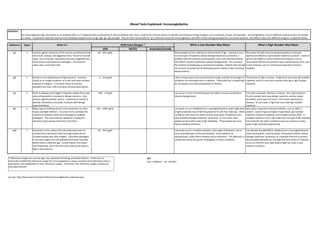
What Immunoglobulins Are and Their Reference Ranges
- 1. Definition: Substance Types What It Is Reference Ranges * What a Low Number May Mean What a High Number May Mean USA UK/EU Australia/Canada IgA 2 Protects against infections of the mucous membranes lining the mouth, airways, and diggestive tract. Found in mucosal areas, such as the gut, respiratory tract and urogenital tract, and prevents colonization by pathogens. Also found in saliva, tears, and breast milk. 80 - 350 mg/dL Some people are born with low or absent levels of IgA. Low levels occur in some types of leukemia, kidney damage (nephrotic syndrome), a problem with the intestines (enteropathy), and a rare inherited disease that affects muscle coordination (ataxia-telangiectasia). This increases the chances of developing an autoimmune disease. Patients with low IgA are at some increased risk of developing severe reactions after receiving blood products. May mean that IgA monoclonal gammopathy of unknown significance (MGUS) or IgA multiple myeloma is present. Levels of IgA are also higher in some autoimmune diseases, such as rheumatoid arthritis and systemic lupus erythematosus (SLE), and in liver diseases, such as cirrhosis and long-term (chronic) hepatitis. IgD 1 Remains in the bloodstream to fight bacteria. Functions mainly as an antigen receptor on B cells that have not been exposed to antigens. It has been shown to activate basophils and mast cells to produce antimicrobial factors. .3 - 3.0 mg/dL Little is known about the normal function of IgD, and few clinical signs or symptoms are associated with its absence. Those with low or absent IgD do not appear unusually predisposed to infection. The function of IgD is unclear. A high level may mean IgD multiple myeloma, which is much less common than IgA or IgG multiple myeloma. IgE 1 Binds to allergens and triggers histamine release from mast cells and basophils; is involved in allergic reactions. Also protects against parasitic worms. Frequently increased in parasitic infestations and atopic inviduals (with allergic hypersensitivity). .002 - .2 mg/dL Can occur in a rare inherited disease that affects muscle coordination (ataxia-telangiectasia). Can mean a parasitic infection is present. Also, high levels are found in people who have allergic reactions, asthma, atopic dermatitis, some types of cancer, and certain autoimmune diseases. In rare cases, a high level may mean IgE multiple myeloma. IgG 4 Major type of antibody found in the blood that can enter tissues and fight infection. In its four forms, provides the majority of antibody-based immunity against invading pathogens. The only antibody capable of crossing the placenta to give passive immunity to the fetus. 620 - 1400 mg/dL Low levels occur in Waldenstrom's macroglobulinemia, where high levels of IgM antibodies may inhibit the growth of B-cells that make IgG. Other conditions that cause low levels include some types of leukemia and a type of kidney damage (nephrotic syndrome). In rare cases, some people are born with a lack of IgG antibodies. These people are more likely to develop infections. May mean a long-term (chronic) infection, such as AIDS, is present. Levels of IgG are higher in IgG MGUS, IgG multiple myeloma, long-term hepatitis, and multiple sclerosis (MS). In multiple myeloma, tumor cells make only one type of IgG antibody (monoclonal); the other conditions cause an increase in many types of IgG antibodies (polyclonal). IgM 1 Expressed on the surface of B cells (monomer) and in a secreted form (pentamer) with very high avidity (forms multiple binding sites with antigen). Eliminates pathogens in the early stages of B-cell mediated (humoral) immunity before there is sufficient IgG. Found mainly in the blood and lymph fluid, and is the first to be made by the body to fight a new infection. 45 - 250 mg/dL Low levels occur in multiple myeloma, some types of leukemia, and in some inherited types of immune diseases. Some patients are asymptomatic, while others develop serious infections. This deficiency is usually discovered during the investigation of other conditions. Can indicate that IgM MGUS, Waldenstrom's macroglobulinemia, early viral hepatitis, mononucleosis, rheumatoid arthritis, kidney damage (nephrotic syndrome), or a parasite infection is present. Because IgM antibodies are the type that form when an infection occurs for the first time, high levels of IgM can mean a new infection is present. KEY: mg = milligrams dL = deciliter see also: http://www.iwmf.com/iwmf-library/immunoglobulins-explained.aspx An immunoglobulin (Ig), also known as an antibody (Ab), is a Y-shaped protein, produced by B-cells and plasma cells, that is used by the immune system to identify and neutralize foreign antigens such as bacteria, viruses, and parasites. Immunoglobulins come in different varieties known as isotypes or classes. In placental mammals, there are five antibody isotypes known as IgA, IgD, IgE, IgG and IgM. They are each named with an "Ig" prefix that stands for immunoglobulin and differ in their biological properties, functional locations, and ability to deal with different antigens, as depicted below. Blood Tests Explained: Immunoglobulins * Reference ranges can vary by age, sex, methods of testing, and other factors. There are no nationally established reference ranges for immunoglobulin values; instead, each laboratory tests a population and establishes its own reference ranges. Therefore, the reference ranges quoted are only approximate.
